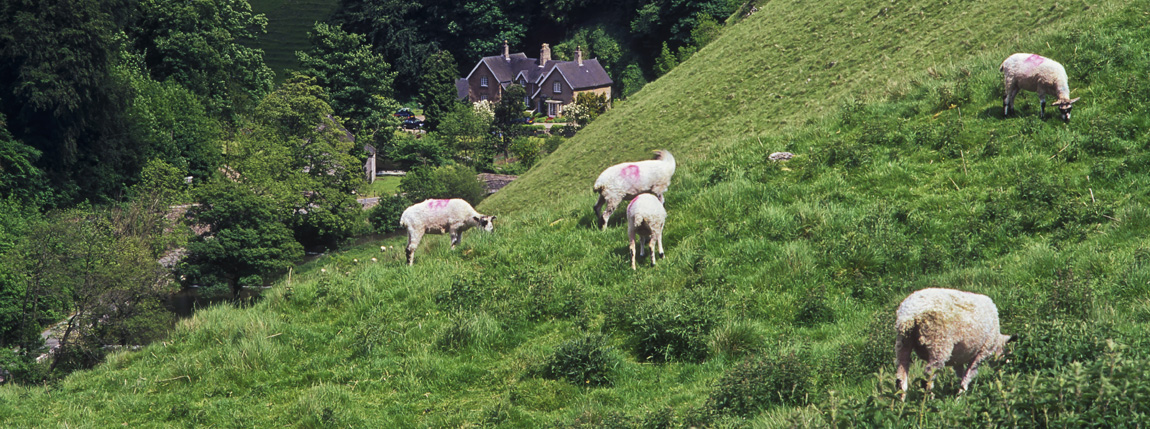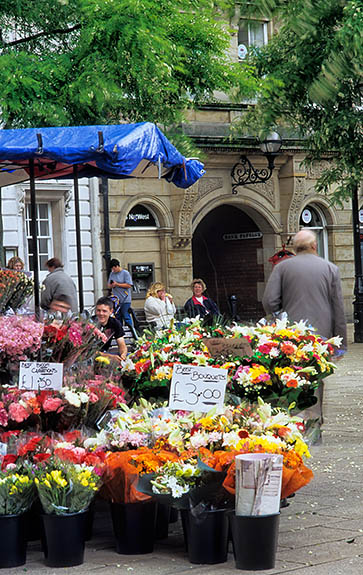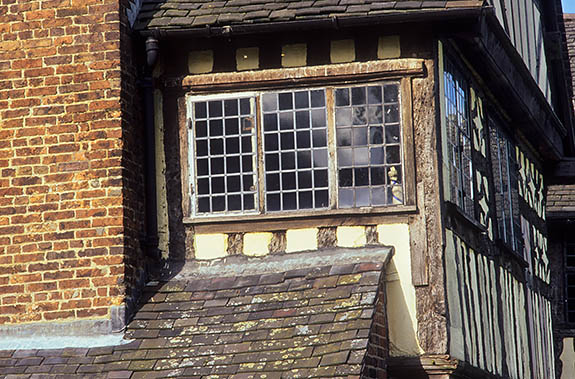
The Compleat Angler:
Izaak Walton's Peaceful World
|
| |

|
|
|
Two friends walk away from London for a long weekend of fishing along a lovely country stream. In the few short days they have away from their jobs, they sit and talk beside a small river lively with fish, walk between hedgerows and through fields grazed by cows, listen to a young milkmaid sings an old ballad, exchange favorite poems, meet old friends at an inn with fresh sheets and lavender in the windows, have a good meal, a good ale, and sing old songs by the fire. Then they walk back to London, promising to do it again real soon. This is the plot of Izaak Walton's 1653 book The Compleat Angler, or the Contemplative Man's Recreation, the English language's most famous how-to book.
|
![ENG: West Midlands Region, Staffordshire, Peak National Park, The River Dove, Beresford Dale, Footbridge crosses the River Dove; footpath sign by a stone wall in meadows on the other side [Ask for #246.234.]](./ImgStore/246.234.575px.jpg) A stone footbridge crosses the River Dove in Dovedale, Peaks District National Park, Staffordshire. |
|
When Walton moved to Staffordshire he was returning home. He had been born there, in just inside Stafford's town gates, the son of an innkeeper. Queen Elizabeth was in the final decade of her long reign, England was at peace at home and abroad, and Stafford was increasing steadily in size and prosperity. Commanding the rich valley of the River Trent on the edge of the Midlands, Stafford had already filled its town walls with medieval and Elizabethan half-timbered buildings, chock-a-block against each other, their second stories overhanging the street to gain just a little more precious space. A square in the middle of town hosted a weekly market large enough to spread out into the surrounding streets, and Stafford's merchants became wealthy men.
|
 Flower vendor on Market Day in Stafford, in England's Midlands.
|
 A restored 17th c. half-timbered farmhouse, Ford Green Hall, in Stoke-on-Trent, near Stafford. |
One major building from Walton's era does survive, right in the center of Stafford: the Ancient High House, an elaborately decorated half-timbered structure that looms four stories over the pavement. Built in 1595 when Walton was two, it is the ostentatious show-house of a wealthy merchant family. Its post-and-beam walls were built of huge oaks set close together, with the spaces between decorated by curved pieces of wood - a show of wealth, as nowhere near that much expensive hardwood was required for structural strength. Each floor juts out a foot or so, so that the fourth story looms far over the sidewalk. Placed only a block from the Market Square, no one doing business with this merchant could overlook his power and importance. Inside, the Stafford Borough Council has restored the High House to its Walton-era appearance, and created a fine museum of 17th century lifestyles and local history. |
![ENG: East Midlands Region, Derbyshire, Peak National Park, The River Dove, Milldale, View toward the village from the hills above. [Ask for #246.299.]](./ImgStore/246.299.575px.jpg) View down into Dovedale and the village Milldale from the hills above, in Peak District National Park, Staffordshire. |
Despite its provincial prosperity, Stafford remained a backwater in the great flow of current events, and a poor Stafford boy would look to London, not the local market, for fame and fortune — as Izaak Walton did around 1613 at age 20. What was unusual was that an uneducated pub-keeper's son would succeed as quickly and as thoroughly as Walton would. Helped into the Ironmonger's Guild by a relative, Walton achieved rapid success with his shop near Fleet Street, selling either hardware or cloth (or perhaps both) from a site near London's legal district. A religious man devoted to the High Church, Walton attended his parish church, St. Dunstan's, and became a close friend and fishing buddy of its vicar - as luck would have it, the great poet John Donne. Upon Donne's death, his friends and relatives thought enough of the ironmonger to ask him to compose the Elegy for Donne's collected poems and the official biography for his collected sermons. This started a sort of mini-career for Walton, who wrote a series of biographies of prominent churchmen, most of them personal friends and fishing chums (including the poet George Herbert). Along the way, Walton seems to have made a good deal of money, as he was able to retire to a country estate at age fifty, never to tend shop again. |
|
That country estate was only a few miles outside his old home town of Stafford, at the hamlet of Shallowford. Visit it today and you will find a lovely two-roomed thatched cottage, modest and homey, by the busy little Meece Brook. The Staffordshire Borough Council has furnished this traditional cottage as a 17th century farm house, with historic displays that include a collection of fishing tackle, and a beautiful herb garden in the back. Walton willed this cottage to Staffordshire, to be used for charitable housing, and it has been in public ownership since his death at age ninety in 1683. Contrary to myth, this was not Walton's own house; it was probably the house of his servants or farm hands. |
![ENG: West Midlands Region, Staffordshire, The Trent Valley, Stafford, Izaak Walton Cottage, Museum staff Peter Sadler and Bruce Braithwaite in period costume in front of the cottage [Ask for #246.323.]](./ImgStore/246.323.575px.jpg) Izaak Walton's Cottage, in Shallowford, near Stafford, Staffordshire. |
|
No one really knows where Walton lived on his Stafford estates, but it wouldn't have been that modest. By this time Walton was well-heeled and well-connected. Walton probably lived in a house similar to nearby Ford Green Hall, now a historic museum run by the City of Stoke-on-Trent. Built by a Stoke area yeoman farmer, this 1624 mini-mansion (constructed when Walton was 31 and still running his London shop) shows how a successful commoner would build a country house. Much more traditional than the homes of the Renaissance-influenced nobility, this handsome post-and-beam structure used the same closely packed oak beams and elaborate wood decoration as the nearby Ancient High House. Its second story juts out in imitation of the wealthy merchant townhouses, while two asymmetric forward-facing gables make it look even larger. Imposing from the front, its beautiful rear garden produced fruits and herbs for the family's table rather than providing a space for a leisured class to stroll. |
![ENG: West Midlands Region, Stoke-on-Trent City, Norton, Ford Green Hall, View of restored 17th c. half-timbered farmhouse, now a city museum, from the front, showing porch over main entrance [Ask for #246.275.]](./ImgStore/246.275.575px.jpg) Ford Green Hall, a 14th C merchant's house in Stoke-on-Trent, near Stafford. |
![ENG: West Midlands Region, Staffordshire, Peak National Park, The River Dove, Beresford Dale, Wild phlox in spring bloom, by the footpath along the River Dove [Ask for #246.232.]](./ImgStore/246.232.575px.jpg) Wild phlox in spring bloom by the footpath along the River Dove, in the Peak District National Park.] |
Retired to such a country house at age fifty, Walton dedicated himself to literary pursuits, socializing with his High Church friends and relatives (he had married into prominent High Church families) — and fishing. Ten years into this idyllic life, Walton published his paean to fishing and the good life, The Compleat Angler, or the Contemplative Man's Recreation. The Compleat Angler remains popular, not as a source of fishing information (Walton, an enthusiastic bottom fisher, has never impressed serious aficionados with his advice), but for its sweet and gentle style, its appreciation of all things beautiful or quiet, and its simple joy in the innocent pleasures of life. In it, Walton does more than fish and talk about fishing. He strolls through fields, talks to a farmwife and listens to her daughter sing an old ballad, enjoys good meals at a country inn, discusses recipes with the innkeeper's wife, meets friends he hasn't seen in too long a time, drinks ale and then sings songs around the fireplace, gives fresh fish to poor families, sleeps peacefully in fresh sheets scented with lavender, and sits quietly by a brook in a gentle summer rain. Using the language of a sweet old man talking with a trusted friend, Walton describes more than good fishing technique; he describes a life lived peacefully. |
|
Walton ended the Staffordshire period of his retirement when he was seventy, upon the death of his second wife. After that he mainly lived far away in Winchester with his good friend Bishop George Morley, drawing a sinecure as the bishop's Steward. However, Walton had already discovered the beauties of the River Dove on the eastern edge of Staffordshire, thirty miles from his Stafford farm. Even after moving far to the South, Walton continued to make frequent trips to the Dove, staying with the local squire, Charles Cotton, a forty year old gentleman and man of letters. Cotton and Walton would fish all along the Dove, Cotton teaching his older friend how to fly fish and carving their initials in the rock spring where the Dove rises. When Walton was past eighty, Cotton built the kindly old man a lovely little fishing "temple" by the banks of the Dove, where the two could shelter on a rainy day, smoke, and talk fish. |
![ENG: West Midlands Region, Staffordshire, Peak National Park, The River Dove, Beresford Dale, Pike Pool. The Pike, a limestone column, rises out of the River Dove. [Ask for #246.230.]](./ImgStore/246.230.575px.jpg) Limestone cliff in the River Dove, in Dovedale, Peaks National Park, Staffordshire. |
![ENG: East Midlands Region, Derbyshire, Peak National Park, Hartington, Biggin, Two lambs rest by their mother, at Biggin Grange [farm] [Ask for #246.242.]](./ImgStore/246.242.575px.jpg) Two lambs rest by their mother in a meadow above Dovedale, in the Peaks District National Park.] |
More than three centuries later the River Dove retains its beauty. The Dove cuts downward through the limestone hills known as the White Peaks, forming a steep sided, narrow bottomed gorge that extends for seven miles between the lovely little village of Hartington and a remote road junction near Ashebourne. A small river, the Dove burbles over limestone rocks and rapids, past white cliffs and peculiar rock spires, passing under the shade of a thick old forest only to break out into a flower-strewn meadow. Cotton's Fishing Temple still sits at the beginning of the gorge, unfortunately on private land but visible from the public footpath that runs the length of the gorge. It's only a short distance from there to Walton's favorite fishing spot, Pike Pool. The "pike" here isn't a fish, it's a tall, thin spire of rock rising straight out of the river like a spear (pike), below a small waterfall. |
![ENG: West Midlands Region, Staffordshire, Peak National Park, The River Dove, Beresford Dale, Pikes Pool, a limestone spire in the middle of the River Dove [Ask for #246.340.]](./ImgStore/246.340.575px.jpg) Pike Pool, a limestone spire in the middle of the River Dove, in Dovedale, in the Peaks National Park. |
![ENG: West Midlands Region, Staffordshire, Peak National Park, Alstonefield, Public footpath runs through the village, behind a stone wall [Ask for #246.352.]](./ImgStore/246.352.575px.jpg) Public footpath runs through the village of Alstonfield, behind a stone wall, in the Peaks District National Park. |
|
For the next three miles Dovedale is much as Walton knew it, a wild little river in a narrow gorge. There are only two substantial changes from Walton's time: there are a lot more people walking the well-kept path, and you can't fish. About half-way down, a narrow little country lane twists down into the gorge, follows it for a half mile, then climbs back out. Known as Mill Dale, this short stretch has an old mill and an older bridge at each end, as well as a tiny hamlet crowded into the gorge bottom and climbing out along a side valley. Below Mill Dale stretches the Dovedale's most popular stretch, a three mile slash through the moors, five hundred feet deep, noted for its ancient woods, strange rock formations, towering cliffs, mysterious caves, and beautiful waterfalls. The gorge ends at a set of stepping stones, taking visitors out of Dovedale and back into the real world. |
![ENG: West Midlands Region, Staffordshire, Peak National Park, The River Dove, Milldale, Sign by the River Dove: "Private Fishing"; by weir [Ask for #246.312.]](./ImgStore/246.312.575px.jpg) Sign by the River Dove, in Dovedale, says "Private Fishing"; located in the Peaks District National Park.] |
![ENG: West Midlands Region, Staffordshire, Peak National Park, The River Dove, Milldale, Walkers relax by the River Dove in the center of the village, a medieval packhorse bridge in the bkgd [Ask for #246.288.]](./ImgStore/246.288.575px.jpg) Walkers relax by the River Dove in the center of the village of Milldale, a medieval packhorse bridge in the bkgd, in Dovedale, part of the Peaks District National Park. |
Izaak Walton's England seems so quiet and peaceful that it is tempting to compare it to the noisy finnimbruns of the industrial world — forgetting that Walton lived in a dangerous world wracked by a vicious civil war. Walton was not so simple that he thought the world good. During the Civil War he was an active Royalist; at age 57 he participated (successfully) in a Royalist plot to smuggle an important royal jewel to France, carrying it personally as far as London. Rather, Walton paints a picture of a world made kind when men pick up the virtues of the angler in their daily lives, live calmly, and "study to be quiet." |
![ENG: East Midlands Region, Derbyshire, Peak National Park, The River Dove, Milldale, View toward the village from the hills above. [Ask for #246.296.]](./ImgStore/246.296.575px.jpg) View into Dovedale from the hills above, in the Peaks District National Park. |
![ENG: West Midlands Region, Staffordshire, Peak National Park, The River Dove, Milldale, View up the River Dove towards the old bridge at Lode Mill [Ask for #246.311.]](./ImgStore/246.311.575px.jpg) View up the River Dove towards the old bridge at Lode Mill |
![ENG: East Midlands Region, Derbyshire, Peak National Park, The River Dove, Milldale, Medieval packhorse bridge over the River Dove, in the center of the village; riverside spring flowers [Ask for #246.294.]](./ImgStore/246.294.1150px.jpg) Medieval packhorse bridge over the River Dove, in the center of the village of Milldale |
|
|
| |
Travel + History
Contact Jim at: jim@JimsBrit.com